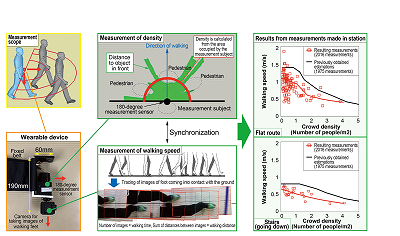21. Passenger crowd density and walking speed in stations
In order to improve the practical convenience and user friendliness of stations, it is important to identify congestion spots and introduce appropriate measures to avoid this congestion. To this end, passenger flow simulation methods that are increasingly becoming the standard tool for identifying congestion spots require models to represent movement, such as passenger walking speed. With regards to measuring walking speed, although there are methods for analysing images of crowd flows taken by high-angle video cameras, because of restrictions on where cameras can be installed and given that there is no standard method for analysing video images, data is not systematically organised.
As such, a new direct measurement method was developed where crowd density and walking speed are measured by a walking subject located among the crowd (Fig. 1). This new method relies on the analysis of the subject's walking movements at foot level, to calculate speed, whilst a small wearable device is used to measure the distance between the subject and surrounding pedestrians in order to calculate crowd density. This not only removes the need to find a camera location, but also means that measurements can be taken anywhere the subject can walk, allowing the collection of quantitative data.
Results from experiments in a station showed that the actual walking speed of people in the station tended to be slower than the walking pace estimated 40 years previously.
The various conditions associated with walking speed characteristics obtained through this method can be used for station design.

